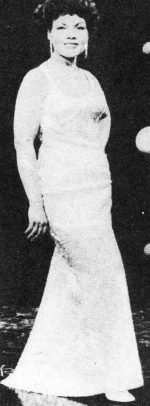It started with the garbage men
Johnny Dankworth is the man behind One Man’s Music

One Man’s Music, a new Granada series featuring songs of the world’s great popular composers, starts on Monday with the work of Jerome Kern. Cleo Laine sings each week, backed by her husband, Johnny Dankworth, and his orchestra. Here David Griffiths writes about one man’s music — Johnny Dankworth’s

THE year was 1944, the number was Duke Ellington’s Mood Indigo, the band rejoiced in the name of Freddy Mirfield’s Garbage Men … and the occasion was the finals of a national dance band contest.
At the microphone: a 17-year-old clarinet player with the lean good looks of a juvenile Frank Sinatra.
A trade paper review said of the show: “Most credit goes to the youthful clarinet player who thought out an original solo for himself instead of using the conventional one of Barney Bigard’s. (Bigard was Ellington’s star clarinettist.)
“He played with a taste and technique that would have been a credit to a professional instrumentalist.”
So began the professional career of Johnny Dankworth, who later confessed: “The truth is, I just didn’t know Bigard’s solo. I had to improvise!”

By 1949 Johnny was himself a judge at music contests, and he was described as the “noted alto sax and clarinet player of the Ambrose Orchestra.” Ambrose was then playing at a London night club.
In those five years the musical outlook of the young Dankworth had undergone a profound change.
He had become a Licentiate of the Royal Academy of Music, and worked in “Geraldo’s Navy” — the bands operated by Geraldo on Cunard liners.
Johnny worked on the Queen Mary. Between voyages he spent days in New York listening to the giants of modern jazz, particularly alto saxophonist Charlie Parker.
“I marvelled at his genius then, as I marvel now,” said Johnny.
“Everything I had heard up to that time was involved with Benny Goodman. Parker changed my thinking.”
Such thinking, in those days, was considered dangerously avante-garde among the entrenched musicians of the swing era. Dankworth found few commercial outlets for his kind of jazz.
But his big chance came. One day he had a call from Ted Heath. “I could hardly believe it,” said Johnny.
At the time Ted had a highly successful series of Sunday afternoon swing sessions at the London Palladium.
“I think Harry Parry was to be that Sunday’s guest star, but was taken ill. Somebody suggested me as a replacement.
“I was deliriously excited. I had to borrow one of my father’s suits.
“Jack Parnell — then playing drums for Ted Heath — was very kind. He offered to lend me one of his.
“Ted introduced me as ‘the young clarinet star’! Within a couple of bars I made the most ear-piercing squeak!
“But Ted was very nice afterwards, and suggested I form my own band.
“So I signed on six young musicians and asked Ted about bookings. All he had was one Palladium date! Not Ted’s fault, of course. I had been misled by my own youth and publicity.”
The Johnny Dankworth Seven made its debut at a 1950 swing session. Fellow musicians were delighted, but the paying public were apathetic.

“FANS BAFFLED BY DANKWORTH’S MASTERPIECES,” said a trade paper. A zealous agent stuck the item in Johnny’s cuttings book … leaving only the last two words of the headline.
But after 10 weeks Johnny called the boys together. “It’s all over,” he told them. “No jobs, no money.”
“We won’t let that bother us,” they replied. “We’ll stick together.”
The Seven survived, even made a little money. Then in 1953 Johnny took the step that often spells disaster. He formed a big band.
What’s more, he made money. Not much, and not often, but just when things were looking black, something always turned up. One example was Johnny’s hit recording of Three Blind Mice.
Today, a reasonably prosperous Johnny Dankworth lives with his wife Cleo Laine at Nether Hall, Bletchley — an hour and a quarter’s drive along the M1 from London’s Tin Pan Alley.
“Cleo and I always wanted to live in the country,” he told me. “And we could do so much more with our money there than we could in the centre of London, where a flat would cost as much as our Bletchley house. And we wanted to bring up our family away from our centre of business.”
It was Johnny who discovered Cleo when he reluctantly agreed to give her an audition with his Seven. He could hardly believe his ears — and his good fortune — and promptly hired her for the group and, subsequently, for the orchestra.
Though they often pursue separate careers (she as an actress as well as a vocal star) they join forces when possible, as in this series.





